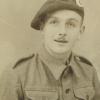The Friends of the AIRBORNE MUSEUM, OOSTERBEEK.
Newsletter No 77, February 2000.
Page 3.
From the Archives (2).
The beginning.
During his visit to Oosterbeek and Arnhem in 1992 as preparation to the writing of his book ‘Arnhem,
The Airborne Battle’, Martin Middlebrook interviewed a number of Dutch eye-witnesses to the battle. With the assistance of the then Arnhem municipal archivist P.R.A. van Iddekinge, he was able to converse with Miss Wilhelmina Schouten, in 1944 deputy headmistress of the Domestic Science School on Rijnkade in Arnhem. She told, among other things, how, on the evening of 17 September 1944, British soldiers knocked on the door of the school and then brought in two wounded soldiers. One of them died the next day and was ‘secretly’ buried in the back garden by Miss Schouten and other civilians.
I was present during this interview with Miss Schouten and couldn’t help asking if she recalled the name of the dead soldier. She replied: “Of course. He was called Maybury, and his mother visited me after the war”. Her son, Corporal Arthur Maybury (30) was a writer, and she gave Miss Schouten copies of two of his books, ‘Thrills with the Paratroops’ and ‘More Thrills with the Paratroops’, both written under the pseudonym ‘Pegasus’ (These books are now in the Arnhem Municipal Archives).
What happened before.
Years earlier, in 1985, I sent Sir John Killick, former British Ambassador in Washington and Moscow, a photograph of himself taken in Weerdjesstraat in Arnhem on 18 September 1944 by photographer Sem Presser. At the time Presser was in hiding in the town and Killick was Commanding Officer of 89 Field Security Section (Intelligence Corps). In the letter that I received by return he wrote that he had never seen the photo before and - even more important - he said that on that Monday he was looking for his Corporal Maybury, who had gone missing near the ship bridge on Sunday evening. Not surprising that he never found him because Maybury lay dying, or was already dead and buried, 50 metres to the south of Weerdjesstraat. I brought Sir John Killick up to date with the facts in 1992, but I never received a reply He died last year.
In conclusion.
According to the Roll of Honour Cpl. Maybury’s field grave was found in 1945 ‘in the garden of abungalow on Utrechtseweg, Oosterbeek’. This probably refers to the garden of the Berghege family,
Where the ABN-AMRO bank now stands.
Question/ riddle.
Why would people from Arnhem or Oosterbeek exhume the remains of a British soldier originallyburied in a garden on Rijnkade and re-bury them in a garden in Oosterbeek?
Adrian Groeneweg.
FOOTNOTE:
In the 5th Revised Edition of the ROLL OF HONOUR, 2011, on page 78 it states: ‘Cpl. Maybury is known to have died in the Huishoudschool on Rijnkade at Arnhem in the early hours of 18 September 1944. He was buried in the garden of the School. His body was removed later by the Germans, and taken to an undisclosed location. The C.W.G.C. Registers read that his field grave was found in Oosterbeek after the war – MR. 693783, Sheet 6NW, in garden of bungalow’.





Latest Comments
There are currently no comments for this content.
Add Comment
In order to add comments you must be registered with ParaData.
If you are currently a ParaData member please login.
If you are not currently a ParaData member but wish to get involved please register.